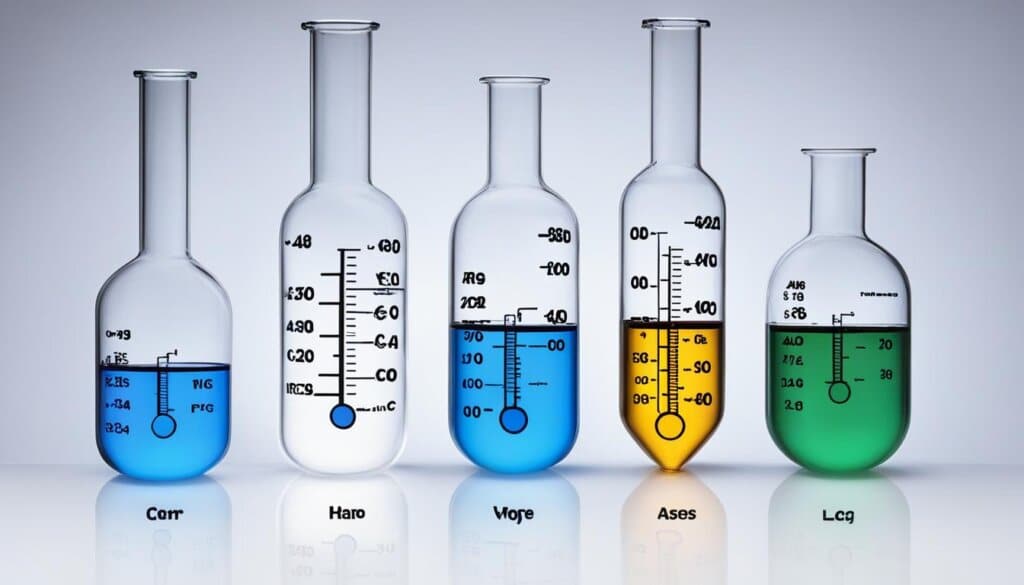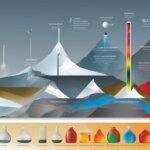Table of Contents
Standard pressure, also known as atmospheric pressure, is a fundamental concept in the fields of science and engineering. It provides a reference point for measuring and comparing various properties of matter. To fully grasp the concept of standard pressure, it is important to understand its definition and how it relates to temperature and pressure.
Standard pressure refers to the nominal conditions of pressure in the atmosphere at sea level. At these conditions, the pressure is considered to be 1 atmosphere (atm) or 101.325 kilopascals (kPa). However, it is crucial to recognize that pressure can vary with changes in altitude and weather conditions.
Standard pressure is a key component when evaluating the behavior of substances, particularly gases, under specific conditions. By establishing a standardized reference point, scientists and engineers can analyze and compare the properties of matter accurately. The understanding of standard pressure is essential in fields such as fluid dynamics, thermodynamics, and environmental sciences.
In the following sections, we will delve into the significance of standard temperature and pressure (STP) and explore how it influences the behavior of gases. We will also identify other standards used as reference points in scientific and engineering practices. So let’s proceed further to gain a comprehensive understanding of standard pressure and its importance in various contexts.
The Importance of Standard Temperature and Pressure (STP)
Standard temperature and pressure (STP) play a crucial role in scientific experiments, particularly those involving gases. STP provides a reference value for various properties of matter, including density, viscosity, melting point, and boiling point. Understanding and adhering to STP conditions is essential when conducting accurate and reliable measurements and calculations.
For gases, STP is defined as a temperature of 0 degrees Celsius (273.15 degrees Kelvin or 32 degrees Fahrenheit) and an absolute pressure of 1 atm. These specific conditions serve as the standard reference point for volume. In fact, at STP, the volume of one mole of an ideal gas is 22.4 liters, a value derived from Avogadro’s law.
STP is not only used to determine gas volume. It also plays a vital role in the ideal gas law, which relates pressure, volume, temperature, and the number of moles of gas. The ideal gas law equation, PV = nRT, allows scientists to calculate and express fluid flow rates, determine the volumes of liquids and gases, and assess the molar volume of gases.
Here is a table summarizing the properties of matter at standard temperature and pressure:
| Property | Value at STP |
|---|---|
| Density | 1.225 kg/m3 |
| Viscosity | 1.789 x 10-5 Pa*s |
| Melting Point | 0 degrees Celsius (32 degrees Fahrenheit) |
| Boiling Point | 100 degrees Celsius (212 degrees Fahrenheit) |
Understanding and utilizing STP conditions are crucial for accurately interpreting experimental results and making meaningful comparisons in scientific research.
Standard Temperature and Pressure for Gases
Gases exhibit different behaviors under standard temperature and pressure (STP) conditions. It is important to understand how gases like oxygen and carbon dioxide behave at STP to accurately analyze their properties and volume. At STP, the behavior of gases can vary, leading to different physical forms and properties.
For example, at STP, 1 milliliter of atmospheric air contains approximately 210 microliters of oxygen. This corresponds to approximately 9.37 micromoles of gas. It is important to note that this measurement can vary slightly depending on other factors such as humidity levels and trace gases in the air.
Carbon dioxide, on the other hand, behaves as a gas at STP. However, it can also exist in other forms under different temperature and pressure conditions. At STP, carbon dioxide is in its gaseous state. However, under extremely low temperatures and high pressures, it can solidify into a substance known as dry ice. On the other hand, under certain conditions of high temperature and extreme pressure, carbon dioxide can become a supercritical fluid, exhibiting properties of both liquids and gases.
Properties of Gases at STP
When considering the volume of gases at STP, the molar volume plays a crucial role. Under standard conditions, the molar volume of a gas is equal to 22.4 liters per mole. This value allows scientists and engineers to calculate and compare the volume of gases accurately.
Understanding how gases behave under standard temperature and pressure conditions is essential for various scientific and engineering applications. By studying the properties of gases like oxygen and carbon dioxide at STP, researchers can determine their behavior, measure their volume accurately, and make informed decisions based on these observations. This knowledge is particularly valuable in fields such as atmospheric science, chemical engineering, and environmental monitoring.

Standard Temperature and Pressure vs. Other Standards
In the world of science and engineering, standard temperature and pressure (STP) serve as crucial reference points for conducting experiments and comparing data. However, STP is not the only standard used in these fields. Other widely recognized standards include normal temperature and pressure (NTP) and standard ambient temperature and pressure (SATP). Understanding the distinctions between these standards is vital for accurate measurements and reliable comparisons.
NTP, defined as a temperature of 20 degrees Celsius and a pressure of 1 atm, is commonly used in laboratory conditions. It provides a convenient reference point for various scientific and engineering applications. SATP, on the other hand, maintains a temperature of 25 degrees Celsius and a pressure of 1 atm. This standard is often employed in ambient conditions to ensure accurate data collection and analysis.
In addition to NTP and SATP, various organizations and industries have adopted their own specific temperature and pressure values for reference. These standards are tailored to suit specific requirements, ensuring consistency within specific fields or applications. Whether it’s the standard state for chemical reactions or the reference conditions for environmental testing, specifying the appropriate temperature and pressure is essential for precise measurement and meaningful comparisons.
FAQ
What is standard pressure and its definition?
Standard pressure refers to the nominal conditions of pressure in the atmosphere at sea level. It is commonly used in scientific and engineering fields to provide a standard reference for comparing and measuring various properties of matter. The standard pressure at sea level is 1 atmosphere (atm) or 101.325 kilopascals (kPa). It is important to note that pressure can vary with changes in altitude and weather conditions.
Why is standard temperature and pressure (STP) important?
STP is essential in scientific experiments, particularly those involving gases. STP provides a reference value for properties of matter such as density, viscosity, melting point, and boiling point. For gases, STP is defined as a temperature of 0 degrees Celsius (273.15 degrees Kelvin or 32 degrees Fahrenheit) and an absolute pressure of 1 atm. These conditions are used to calculate and express fluid flow rates, volumes of liquids and gases, and the molar volume of gases. The ideal gas law, PV = nRT, is commonly used to relate pressure, volume, temperature, and number of moles of gas.
What behaviors do gases exhibit under standard temperature and pressure conditions?
Gases exhibit different behaviors under standard temperature and pressure conditions. For example, at STP, 1 milliliter of atmospheric air contains approximately 210 microliters of oxygen, which is equivalent to 9.37 micromoles of gas. The properties of gases, such as carbon dioxide, can also change at different temperature and pressure conditions. At STP, carbon dioxide behaves as a gas, but it can also exist as a solid called dry ice or as a supercritical fluid. The volume of a gas at STP is 22.4 liters per mole.
Are standard temperature and pressure (STP) the only reference conditions used in scientific and engineering fields?
No, there are other common reference conditions used in scientific and engineering fields. These include normal temperature and pressure (NTP) and standard ambient temperature and pressure (SATP). NTP is defined as a temperature of 20 degrees Celsius and a pressure of 1 atm, while SATP is defined as a temperature of 25 degrees Celsius and a pressure of 1 atm. Additionally, there are various standards used by different organizations and industries, each with its own specific temperature and pressure values. It is important to explicitly state the reference conditions when reporting data or conducting experiments to ensure accurate comparisons and measurements.







